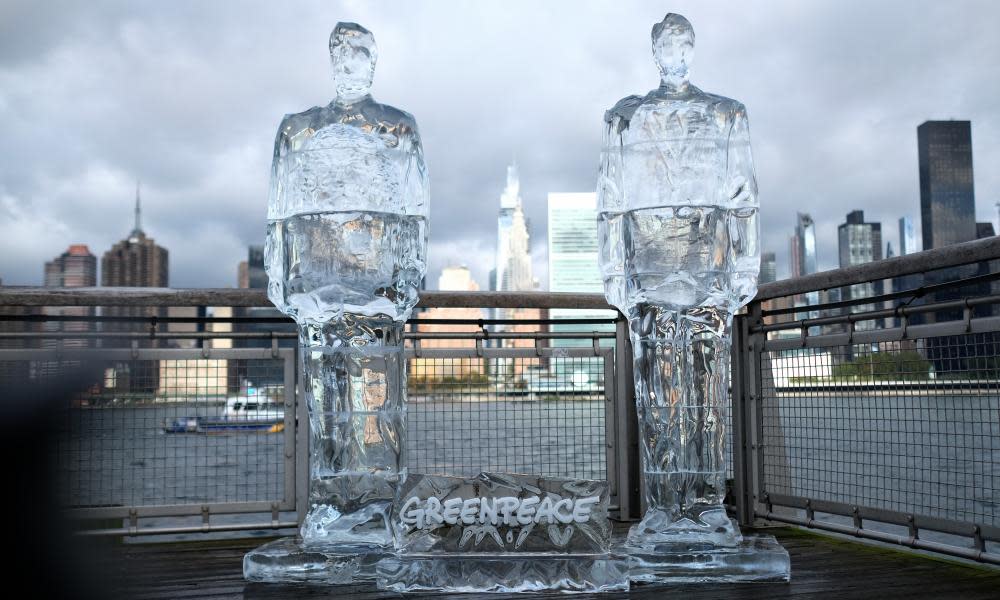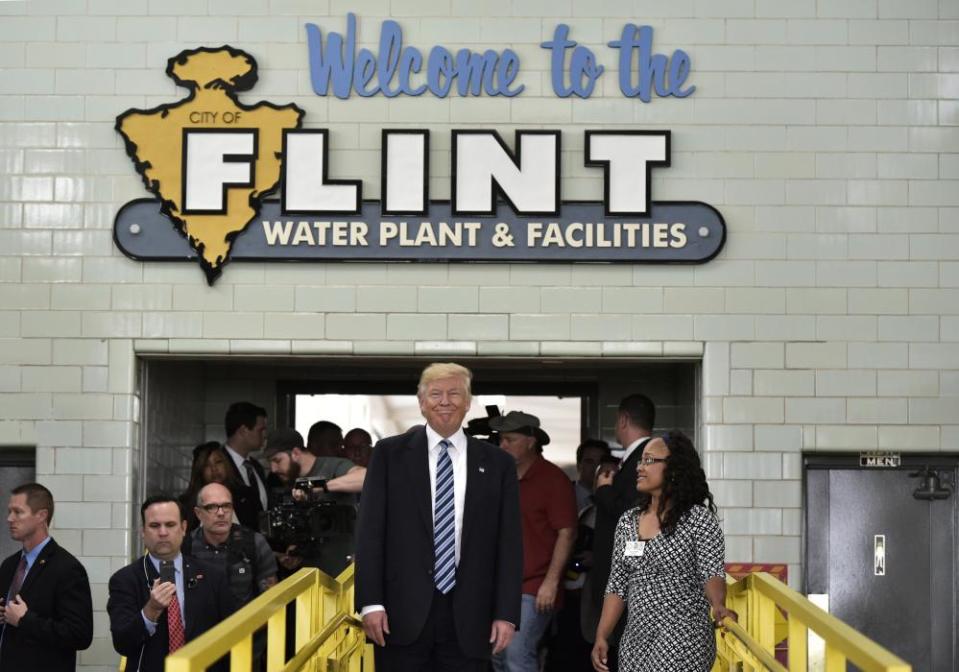Trump's environment agency seems to be at war with the environment, say ex-officials
- Oops!Something went wrong.Please try again later.

Donald Trump’s environment agency “actually seems to have a war on the environment”, has been “utterly untenable”, and has brought about “deeply, deeply troubling times”, according to three administrators appointed under past presidents.
Reflecting on Trump’s dozens of attacks on core environmental protections, a fourth put it another way: “[I’m] really god damned pissed off – and that’s being kind.”
The former environment administrators, two Republicans and two Democrats, shared their frustrations on a Joe Biden campaign call and in a separate conversation with reporters within the last several weeks. They are: Bill Reilly, from the George HW Bush administration; Christine Todd Whitman, from the George W Bush administration; Carol Browner, from the Bill Clinton administration, and Gina McCarthy, from the Barack Obama administration.
Related: Trump administration ends gray wolf's endangered species protections
They have more than enough evidence to cite – Trump’s Environmental Protection Agency (EPA) has reversed rules meant to clean up the air, defend waterways from industrial pollution and fight climate change.
Trump has brought the agency to an all-time low, his critics argue. According to a report from the Environmental Protection Network of more than 500 former agency officials, the rollbacks have had “serious and measurable consequences, especially for already overburdened low-income communities and communities of color”.
The impacts will include “more respiratory illness and heart disease” that shortens lives; “decreased water quality” for drinking water, fisheries and recreation; “reduced Superfund cleanups,”; and “devastating consequences” from unchecked climate change, the group said.
But EPA’s problems started long before Trump was elected in 2016.
Fifty years after its creation under the Nixon administration, the EPA has found itself outgunned by industry. The agency’s budget and staffing have withered over the past generation – while industry has tightened its grip on the political system and entrenched new sectors with minimal oversight.
Amid a scientific revolution in understanding human and environmental responses to pollution, regulators have been unable to translate many of those findings into stronger safeguards.

Those concerns are detailed by 76 current and former EPA staffers interviewed over the past several years, in research under peer review. Trump has “accelerated a longer-term decline in EPA resources, expertise, and authority”, according to the findings by researchers with the Environmental Data & Governance Initiative.
As one EPA staffer explained: “People noticed that the environment was a mess in the 70s and we needed to clean it. Well, we’ve cleaned it … The air is generally safe … and we don’t have the blood lead level problems that we used to have.
“It’s not well appreciated how much work it takes to maintain that.”
In response to questions about the agency’s record under Trump, spokesman James Hewitt criticized former EPA administrators for their handling of air pollution around Ground Zero after the 9/11 terrorist attacks and of the Flint drinking water crisis.
Hewitt said air quality had improved 7% under Trump, although an Associated Press report found air quality improvements are stagnating after years of progress.
He said the Trump administration delisted as many toxic Superfund sites in four years as Obama did in eight years, but Huffington Post reported that the number of priority sites is up and the number of unfunded sites has ballooned.
The spokesman added the EPA was close to updating a rule for lead and copper that hasn’t been revised in 30 years, but critics say the changes won’t go far enough.
The numbers demonstrate EPA has become hamstrung:
The agency has 14,172 employees, about one for every 23,161 US residents, according to a separate report by EDGI.
In comparison, the transportation department has almost four times as many employees, and the agriculture department has roughly six times as many employees as EPA, according to the Office of Personnel Management, which uses slightly different numbers.
EPA staffing peaked in 1999 and fell 21.7% by 2019, to about the same number of staffers as under President Ronald Reagan in the 1980s.
The agency’s budget has not fared much better. In 1999, it was $7.6bn. Adjusting only for inflation, it should be $11.7bn today. But it is not, it is $9.1bn.
Many staff interviewed in the research blamed the politicization of the environment. Over the past few decades, Republicans have become more aligned with polluting industries and opposed to regulation, calling it government interference in the free market.
The most dividing issue is climate change. While polls show an overwhelming majority of Americans support environmental protections, they also find that Republicans are far less likely than Democrats to be worried about how humans are forcing temperatures higher and causing more extreme weather.
“This agency is in the process of giving up on protecting people. It’s much more interested, at least the leadership is, in protecting the regulated community,” said Christopher Sellers, the lead researcher and a professor of environmental history at Stonybrook University.
“I would not trust this agency.”
Sellers’ conclusion is supported by another analysis by researchers in the American Journal of Public Health, which in 2018 warned the agency was on the edge of “regulatory capture”. Journalists have consistently reported that top Trump officials have done exactly what corporations have asked for, while refusing to meet with environmental advocates.

For example, a coal executive who fundraised for Trump saw his plan carried out almost to the letter. A trucking company donated $225,000 to a congressional candidate and got signoff for its super-polluting big rigs. After heavy lobbying, EPA scaled back how it determines the risks of dangerous chemicals.
Trump’s EPA did not respond to inquiries about research and reporting showing the heavy influence of industry but did provide a list of environmental groups it said it met with over the last year. Some of those groups told the Guardian their interactions with EPA were severely limited compared with previous administrations.
Perhaps the EPA’s weakest point has been in protecting the most vulnerable Americans – those who live near polluting facilities and are often low-income and people of color. The agency has no formal way of measuring all the impacts of living near multiple threats. For example, it does not know what happens to a person who breathes dirty air from a highway and a power plant and also drinks contaminated water.
“Most environmental statutes … focus sort of point source by point source, facility by facility, and fail to look at the cumulative impacts,” much less the race or incomes of those who bear these impacts, said one staffer interviewed.
Six former EPA administrators joined other former officials in August in an open letter calling to “reset the course” at the agency.
In a project from the Environmental Protection Network, they have recommended changes for curbing vehicle pollution, safeguarding water, relying more on science and elevating environmental justice.
Stan Meiburg, who was deputy regional administrator of EPA’s Atlanta office, said states also do not have the necessary resources to protect people.
“When there is a crisis, state and local agencies and EPA can respond. But what I worry about more is can they anticipate things to prevent problems from happening, rather than just waiting until a disaster strikes,” Meiburg said.
“When you think about the post-Trump EPA, the issue is not just to rebuild what was, but to do something to meet the challenges of the future.”
This article was amended on 30 October 2020 after an editing error interchanged the administrations in which Christine Todd Whitman and Carol Browner worked.

